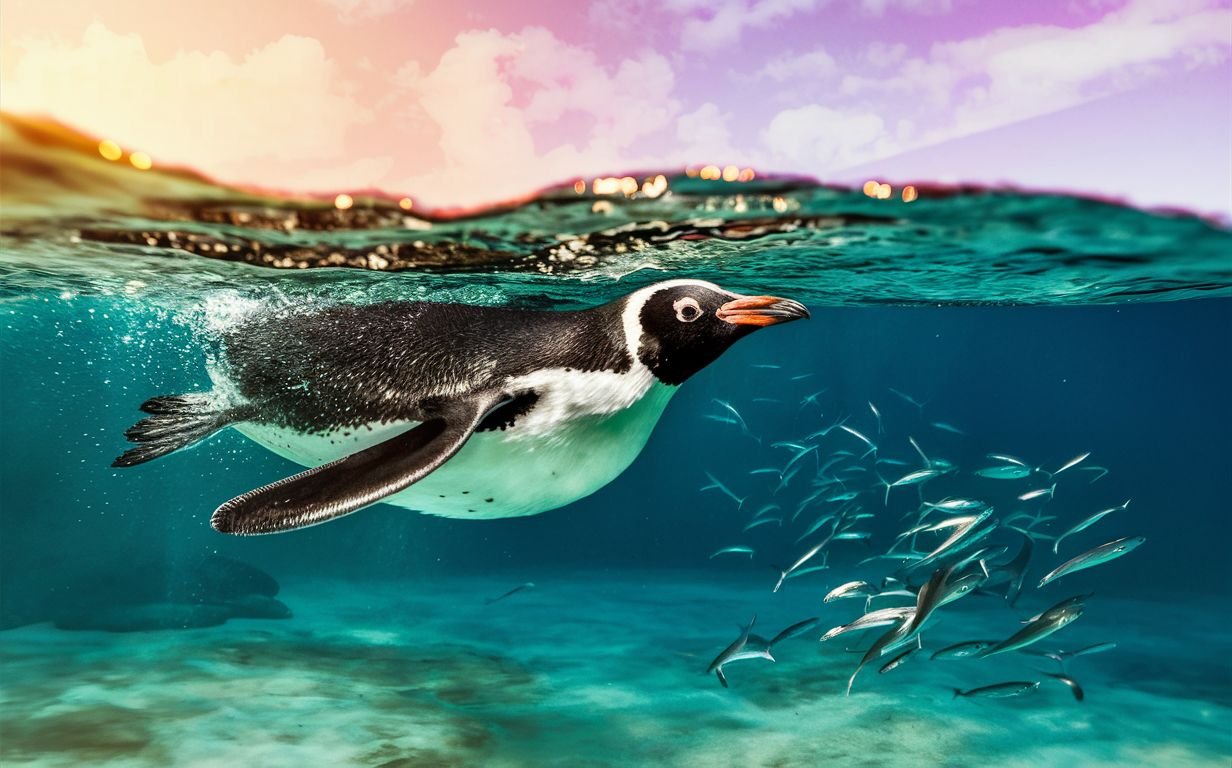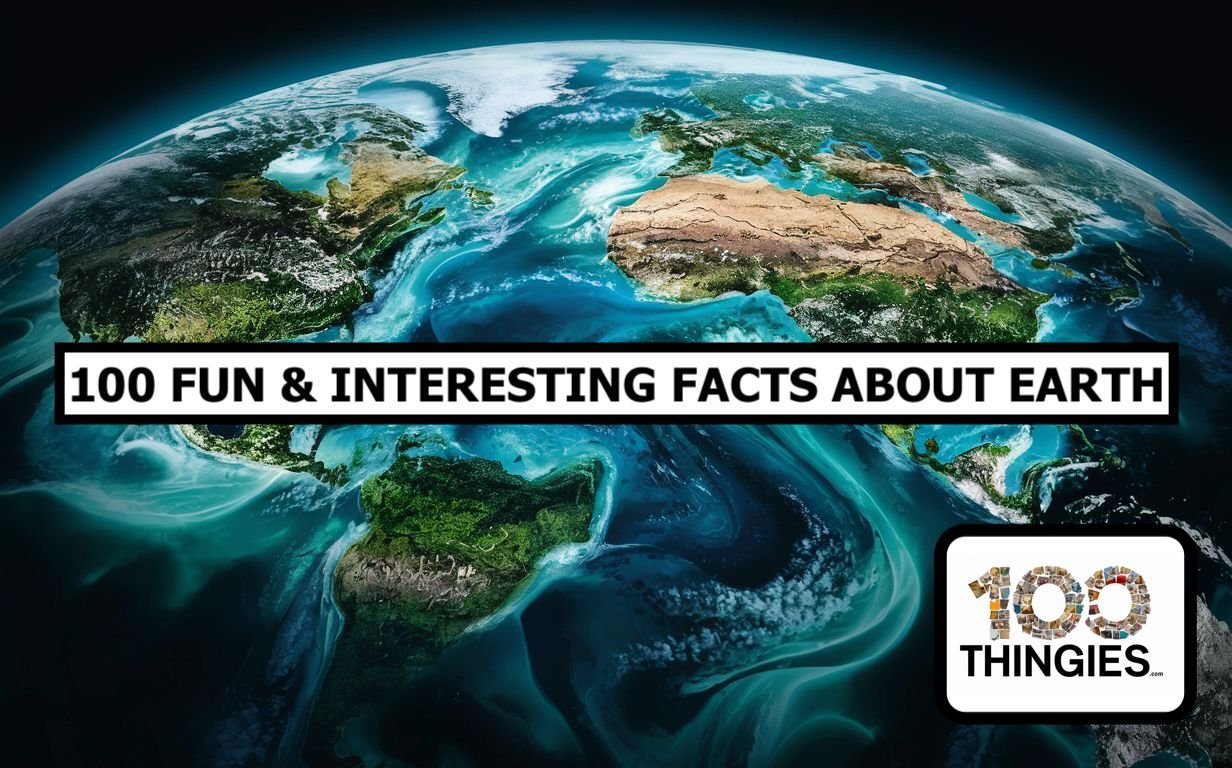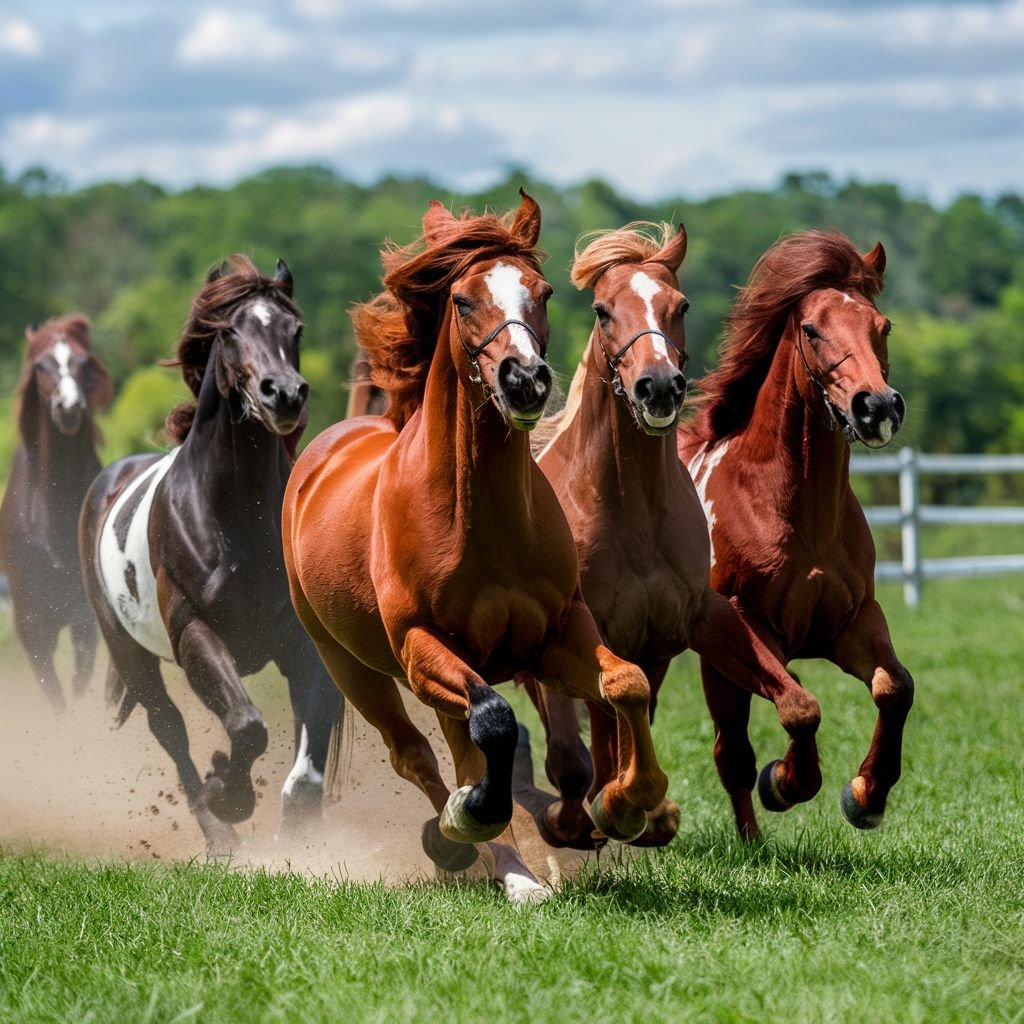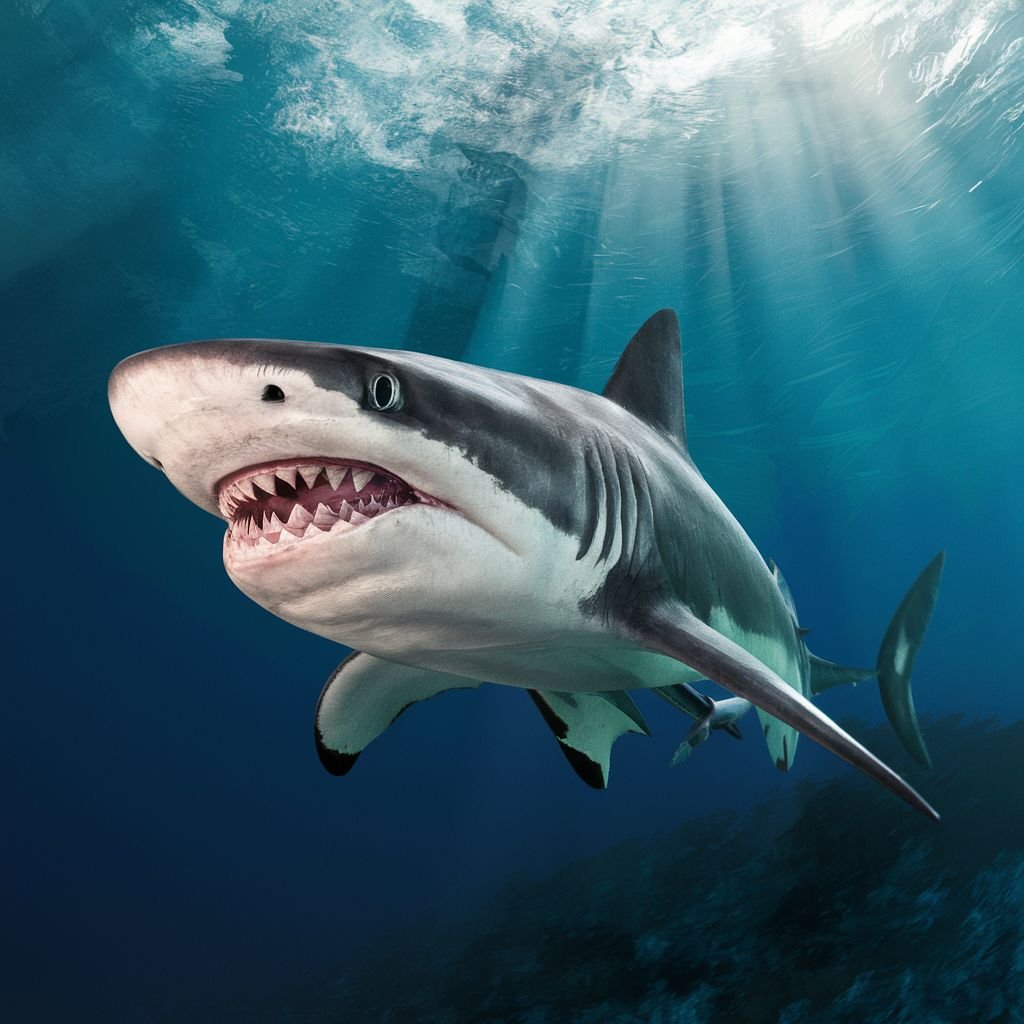You probably know that penguins do not fly, but what else do you know about them? Join us as we go through this episode of 100Thingies.com; 100 fun and interesting facts about penguins.
1. Penguins are exclusively native to the Southern Hemisphere.
Penguins are found solely in the Southern Hemisphere, from the icy shores of Antarctica to more temperate regions near the equator, such as the Galápagos Islands. This distribution means no penguins are native to the Northern Hemisphere, debunking the myth that they coexist with polar bears, which live in the Arctic.
2. Emperor Penguins are the tallest and heaviest of all penguin species.
The Emperor Penguin (Aptenodytes forsteri) is the largest of the penguin species, standing up to 122 cm (48 in) tall and weighing up to 40 kg (88 lbs). These majestic birds are well adapted to their Antarctic home, with special adaptations like a layer of highly efficient fat and feathered insulation to combat the cold.
3. Penguins are superbly adapted to life in the water.
Penguins’ bodies are highly adapted for aquatic life. Their wings have evolved into flippers used for powerful propulsion in the water, and their bodies are streamlined for efficient swimming. Penguins can reach speeds of up to 25 km/h (15.5 mph) in water, making them agile and adept swimmers.
4. Penguins can drink salt water.
Thanks to a specialized gland located near their eyes, penguins can filter salt from the seawater they ingest. This supraorbital gland removes salt from their bloodstream, which they then expel through their beaks or by sneezing, allowing them to survive without fresh water.
5. The smallest penguin species is the Little Blue Penguin.
The Little Blue Penguin (Eudyptula minor), also known as the Fairy Penguin, stands around 33 cm (13 in) tall and weighs about 1 kg (2.2 lbs). True to its name, it has a unique blue tint to its feathers and inhabits coastal areas in New Zealand and southern Australia.
6. Penguins are monogamous during breeding seasons.
Many penguin species are monogamous for the duration of the breeding season, with some pairs reuniting year after year to raise their offspring. This monogamous behavior includes courtship rituals, which can involve vocalizations, displays, and mutual preening.
7. Penguin populations are indicators of ocean health.
Penguins are considered indicator species, meaning changes in their populations can reflect changes in the marine environment, including shifts in fish populations, water temperature, and ice conditions. Monitoring penguin populations helps scientists assess the health of the Southern Ocean ecosystem.
8. Penguins’ black and white coloring is a form of camouflage.

Penguins’ distinctive black and white plumage serves as camouflage while swimming. The white underside blends with the bright sunlight when viewed from below, and the dark back conceals them against the darker ocean surface from above, protecting them from predators.
9. Penguins have a specialized social behavior.
Penguins are highly social birds that live in large colonies, which can include thousands of individuals. These colonies help provide protection against predators and aid in warming each other in cold temperatures through huddling together, showcasing their complex social structures and behaviors.
10. Not all penguins live in cold climates.
While often associated with Antarctica’s icy landscapes, several penguin species live in temperate or even tropical climates. For example, the Galápagos Penguin (Spheniscus mendiculus) lives near the equator, and the African Penguin (Spheniscus demersus) resides along the southern African coast, demonstrating the adaptability and diversity of penguins across various environments.
11. Penguins are flightless birds.
Despite being birds, penguins cannot fly. Their wings have evolved into flippers for swimming, and their bodies are adapted to be sleek and efficient in water rather than air. This adaptation makes them exceptional swimmers but incapable of airborne flight, contrasting them with most other bird species.
12. The Emperor Penguin’s breeding cycle is timed to Antarctic winters.
Emperor Penguins lay their eggs and raise their chicks during the harsh Antarctic winter. This timing ensures that their offspring are mature enough to go to sea in the summer when food is more abundant. The males incubate the eggs on their feet under a fold of skin, going without food for up to two months in the coldest, darkest conditions on Earth.
13. Penguin chicks are born with a fluffy down.
Penguin chicks hatch covered in a thick, fluffy down that provides insulation against the cold. This down is later replaced by waterproof juvenile feathers as they grow older, a process known as fledging, which prepares them for life in the water.
14. Penguins have an exceptional sense of hearing.
Penguins have highly developed hearing, essential for communication in noisy breeding colonies and potentially for navigating and detecting prey underwater. Their ears are adapted to pick up the frequencies of sounds made by fellow penguins, enabling them to identify their mates and chicks amid the cacophony of a crowded colony.
15. Leopard seals and killer whales are among penguins’ main predators.
In the wild, penguins face several predators, both in the water and on land. In the water, leopard seals and killer whales are their main threats, adept at hunting penguins when they venture out to feed. On land and ice, skuas and giant petrels can prey on eggs and chicks, showcasing the dangers penguins face throughout their life cycle.
16. Penguins engage in a behavior known as “tobogganing.”
To move quickly over ice and snow, penguins will often fall onto their stomachs and propel themselves forward with their flippers and feet in a movement known as tobogganing. This not only conserves energy but also allows them to move at surprisingly fast speeds when needed.
17. Penguins can dive to great depths in search of food.
Some penguin species, such as the Emperor Penguin, can dive to depths of over 500 meters (1,640 feet) and hold their breath for more than 20 minutes as they search for fish, krill, and squid. These deep dives are facilitated by their unique physiology, which allows them to store oxygen and reduce their oxygen consumption underwater.
18. Penguins’ eyes work better underwater than in the air.
Penguin eyes are adapted for clear vision underwater, where they spend a significant amount of time hunting for food. Their eyes are better suited to the refractive index of water than air, enabling them to see with more clarity and precision beneath the surface than above it.
19. The Galápagos Penguin is the only penguin species that ventures into the Northern Hemisphere.
The Galápagos Penguin is unique among penguins for sometimes swimming into the Northern Hemisphere while feeding. However, it breeds and resides exclusively in the Galápagos Islands, which straddle the equator, making it the most northerly penguin species.
20. Penguins have a spiny tongue and throat to help catch prey.
The inside of a penguin’s mouth is equipped with backward-facing spines on the tongue and roof of the mouth. These spines help grip slippery prey such as fish and squid, ensuring that their food does not escape once caught, demonstrating yet another adaptation to their aquatic lifestyle.
21. Penguins participate in mutual preening, known as “allopreening.”
Allopreening is a social behavior in which penguins groom each other, removing parasites, dirt, and adjusting each other’s feathers. This not only helps maintain their waterproof coating but also strengthens social bonds within the group, an essential aspect of penguin social life that promotes cohesion and cooperation.
22. The Yellow-eyed Penguin is considered one of the world’s rarest penguin species.
Found in New Zealand, the Yellow-eyed Penguin, or Hoiho, is distinguished by its pale yellow eyes and a band of yellow feathers running from its eyes around the back of the head. With populations threatened by habitat destruction, introduced predators, and human disturbance, conservation efforts are crucial to prevent its extinction.
23. Penguins lose all their feathers at once in a process called “catastrophic molting.”

Unlike many birds that shed a few feathers at a time, penguins undergo a catastrophic molt once a year, where they replace all their feathers over a short period. During this time, they cannot enter the water to feed because their new feathers aren’t waterproof yet, so they must live off stored fat reserves.
24. Some penguin species create nests, while others incubate eggs on their feet.
Nesting behaviors vary among penguin species. For example, Emperor and King Penguins incubate a single egg on their feet, covered by a flap of abdominal skin to keep it warm. In contrast, species like the Gentoo Penguin build nests from stones, sticks, and vegetation to protect their eggs from the cold ground.
25. Penguins have been recorded as making a variety of sounds for communication.
Penguins use a complex system of vocalizations to communicate, which is particularly important during breeding season for identifying mates and offspring. Sounds range from trumpeting calls to softer, more intimate vocalizations between parents and chicks, each serving specific purposes in their social interactions.
26. The African Penguin is also known by the nickname “Jackass Penguin” due to its braying call.
The African Penguin, found along the southern African coast, earns its nickname from its loud, donkey-like bray. This distinctive call plays a vital role in communication among these birds, particularly during mating season when males use it to attract females and establish territory.
27. Penguins have been known to form lifelong bonds with their partners.
While not all species are strictly monogamous for life, many penguins form long-term pair bonds, reuniting with the same partner year after year during the breeding season. These bonds are reinforced through behaviors like allopreening and synchronized movements, which help maintain pair cohesion.
28. Fossil records show that ancient penguins were much larger than today’s species.
Fossil discoveries have revealed that prehistoric penguins were significantly larger than any species alive today, with some ancient species standing nearly 2 meters (6.5 feet) tall and weighing over 100 kilograms (220 pounds). These giant penguins roamed the oceans millions of years ago, long before human observers.
29. Penguin feet are adapted to walking on ice and swimming.
Penguins’ feet are equipped with a network of blood vessels that helps regulate their temperature, preventing them from freezing on ice and efficiently propelling them in water. Their strong, webbed feet are excellent for steering and maneuvering while swimming, as well as for walking and climbing on rugged terrain.
30. Climate change poses a significant threat to penguin populations worldwide.
Global warming and the resulting changes in sea ice patterns, ocean temperatures, and prey availability pose significant threats to penguin species, particularly those dependent on Antarctic ice for breeding. Changes in their environment can lead to decreased breeding success and food scarcity, challenging the survival of these adapted creatures in their natural habitats.
31. The Fiordland Penguin uses its flippers to “fly” through dense forest.
The Fiordland Penguin, native to New Zealand, exhibits a unique behavior among penguins by traversing dense forest environments to reach their nesting sites. They use their strong flippers not just for swimming but also to help navigate and propel themselves through the forest underbrush, demonstrating remarkable adaptability to their environment.
32. Penguins’ bones are denser than those of other birds, aiding in diving.

Unlike birds that fly, penguins have solid, dense bones that reduce buoyancy and enable them to dive deep underwater. This adaptation allows them to pursue prey at depths that would be inaccessible to birds with lighter, air-filled bones, showcasing an evolutionary trade-off for their aquatic lifestyle.
33. Penguin colonies are sometimes visible from space.
Large penguin colonies, such as those of the Emperor Penguin, can be so extensive that they are visible from space. Satellite imagery has been used to discover previously unknown colonies by spotting the stains left on the ice by their guano (feces), demonstrating the large scale of these gatherings.
34. The Rockhopper Penguin is named for its distinctive hopping movements.
Rockhopper Penguins are named for their unique ability to hop over rocks and obstacles, rather than waddling like many other penguin species. This agile movement helps them navigate the rocky shorelines and cliffs where they live and breed, highlighting their adaptation to specific environments.
35. Penguins can control the blood flow to their extremities to manage body temperature.
To survive in cold environments, penguins have the ability to regulate the flow of blood to their extremities, reducing it to minimize heat loss and directing it inward to keep their core temperature stable. This counter-current heat exchange system is a critical adaptation for conserving warmth in icy waters and frigid climates.
36. The Royal Penguin is found exclusively on Macquarie Island.
The Royal Penguin breeds only on Macquarie Island, located in the sub-Antarctic region between New Zealand and Antarctica. This species is distinguished by its white face and unique feather patterns, and its restricted breeding range makes habitat protection crucial for its survival.
37. Penguins have a thick layer of fat called blubber for insulation.
In addition to their dense feathers, penguins have a layer of blubber under their skin that provides insulation against the cold. This fat layer is especially important for species living in the Antarctic, helping them maintain body heat in freezing temperatures and serving as an energy reserve during fasting periods.
38. Adélie Penguins build their nests out of stones.
Adélie Penguins use stones to build circular nests on the Antarctic continent and surrounding islands. These stones are valuable commodities in Adélie colonies, often leading to “theft” between penguins as they attempt to create the perfect nesting site to attract mates and protect their eggs from meltwater.
39. Penguins exhibit a wide variety of feeding techniques.
Penguins employ diverse strategies to catch their prey, including pursuit diving, where they chase fish and squid underwater, and surface seizing, where they grab prey near the water’s surface. These techniques vary by species and are adapted to the specific hunting conditions of their environment.
40. Magellanic Penguins are named after the explorer Ferdinand Magellan.
Magellanic Penguins, native to southern South America, were named after the Portuguese explorer Ferdinand Magellan, who first recorded seeing them in 1520 during his circumnavigation of the globe. These medium-sized penguins are characterized by the distinctive black bands on their chests and their burrowing nesting habits.
41. Penguins can sleep standing up or lying down.
Penguins have the ability to sleep either standing up or lying on their stomachs. In colonies, they may stand closely together for warmth and security, often sleeping on their feet. When on ice or softer ground, they might lie down, using their flippers for balance and insulation against the cold surface.
42. Gentoo Penguins are the fastest-swimming penguin species.
Gentoo Penguins hold the title for the fastest underwater swimming speed among penguins, reaching speeds of up to 36 kilometers per hour (22 mph). This incredible speed allows them to evade predators and catch their prey, showcasing their remarkable adaptations for life in the water.
43. The Snares Penguin is named after its native habitat, the Snares Islands.
Native exclusively to the Snares Islands, south of New Zealand, the Snares Penguin is adapted to the unique environment of these remote islands. With no natural land predators in their habitat, Snares Penguins exhibit less fear, allowing for close human observation. Their isolation has also contributed to their distinct behaviors and breeding practices.
44. Penguins can recognize individual vocalizations.
Penguins have the remarkable ability to recognize the specific calls of their mates and offspring amidst the noisy environment of their colonies. This vocal recognition is crucial for maintaining social bonds, reuniting family members after foraging trips, and ensuring the survival of their chicks in densely populated breeding grounds.
45. The Chinstrap Penguin gets its name from the narrow black band under its head.
The Chinstrap Penguin is easily identifiable by the thin black band that runs under its head from one side of the face to the other, resembling a helmet chinstrap. This distinctive feature, along with its aggressive nature when defending territory, makes the Chinstrap one of the most easily recognized penguin species.
46. Penguin colonies are known as rookeries.

Gather up rookeries! The large gatherings of penguins for breeding, molting, and other communal activities are referred to as rookeries. These dense congregations can number in the thousands, providing safety in numbers from predators and facilitating social interactions important for mating and raising young.
47. The White-flippered Penguin is considered a subspecies or morph of the Little Blue Penguin.
Found mainly on the Banks Peninsula and nearby islands off the coast of New Zealand’s South Island, the White-flippered Penguin is often considered a subspecies or a morphological variant of the Little Blue Penguin. It is characterized by its slightly larger size and the distinctive white borders along the edges of its flippers.
48. Penguins have a special gland that helps remove salt from their bloodstream.
The supraorbital gland, located near a penguin’s eyes, functions to filter salt from their bloodstream, which is ingested while swimming in the ocean. This adaptation allows penguins to drink seawater when necessary and maintain hydration without access to fresh water.
49. Penguin feathers are tightly packed to provide waterproofing and insulation.
Penguin feathers are small, densely packed, and overlap each other, creating a waterproof layer that traps air for insulation. This feather structure is essential for keeping them dry and warm in cold, wet environments, allowing them to spend extended periods in the water while minimizing heat loss.
50. The Erect-crested Penguin is known for its distinctive, upright feather crest.
The Erect-crested Penguin, found on the Bounty and Antipodes Islands south of New Zealand, features a striking crest of stiff yellow feathers that stand up on the top of its head. This unique characteristic, along with its expressive blue eyes, distinguishes it from other crested penguin species, although it shares their propensity for dramatic displays and vocalizations.
51. Penguins exhibit a behavior known as “pebbling” during nest building.
Many penguin species, especially those that build nests, engage in a behavior called “pebbling,” where they collect stones and pebbles to construct and reinforce their nests. These pebbles are highly prized, leading to competition and even theft among penguins. This behavior emphasizes the importance of nest construction for egg protection and thermal insulation.
52. Macaroni Penguins are named after an 18th-century fashion trend.
The Macaroni Penguin got its name from the yellow and black plumes on its head, reminiscent of the flamboyant “macaroni” fashion in 18th-century England. The term “macaroni” was used to describe men who adorned themselves with excessive ornaments, similar to the penguin’s distinctive crest.
53. Some penguin species perform synchronized group dives while foraging.
Penguins, particularly those in large colonies, often engage in synchronized diving when foraging for food. This group behavior helps in overwhelming prey and reducing individual risk from predators. Synchronized dives demonstrate the complexity of penguin social behavior and their ability to cooperate for mutual benefit.
54. The Yellow-eyed Penguin is one of the few penguin species that is solitary outside of breeding season.
Unlike most penguin species that form large colonies, the Yellow-eyed Penguin tends to be more solitary, especially outside the breeding season. They prefer to nest in secluded spots hidden from their peers, highlighting a unique aspect of their behavior compared to the highly social nature of other penguins.
55. Penguins have been known to travel vast distances in search of food.
Penguins are capable of covering substantial distances during their foraging expeditions. Emperor Penguins, for example, can travel up to 900 kilometers (560 miles) round trip from their breeding sites to open water in search of food, showcasing their endurance and the lengths they go to support their chicks.
56. The Galápagos Penguin’s ability to survive at the equator is due to cool currents.
The Galápagos Penguin, the only penguin species that lives north of the equator, can survive in the tropical climate due to the cool waters brought by the Humboldt and Cromwell currents. These currents help moderate the temperature, allowing the penguins to thrive despite the equatorial heat.
57. Fossil evidence suggests penguins once flew.
While modern penguins are flightless, fossil records indicate that ancient penguins could fly. Over millions of years, their wings evolved into flippers for swimming, an adaptation driven by the rich food sources available in the ocean. This evolutionary transition reflects the trade-offs between flight and aquatic proficiency.
58. The Banded Penguin group includes species like the African, Humboldt, Magellanic, and Galápagos penguins.
The Banded Penguins, characterized by the distinctive black bands across their chests, include several species adapted to warmer climates than their Antarctic cousins. These species share common physical traits and behaviors but are spread across various habitats in the southern hemisphere, demonstrating the diverse adaptations within the penguin family.
59. Penguins are adept at conserving oxygen during dives.
Penguins’ bodies are highly adapted for efficient oxygen use during their deep dives. By slowing their heart rate and directing oxygen primarily to essential organs, they can extend their underwater foraging trips. This physiological adaptation allows them to dive deeper and stay submerged longer than would otherwise be possible.
60. Parental care is shared in many penguin species.
In many penguin species, both parents share the duties of incubating eggs and feeding the chicks. This shared parental investment ensures the highest possible survival rate for their offspring, as both parents take turns foraging at sea and caring for the young, highlighting the cooperative nature of penguin family life.
61. Penguins use body language for communication.
Penguins communicate not only through vocalizations but also through a variety of body language cues, including head bobbing, flipper waving, and bowing. These behaviors are essential for establishing territory, signaling aggression or submission, and reinforcing social bonds within the colony, demonstrating the complexity of their social interactions.
62. The African Penguin has distinctive pink glands above its eyes.

The African Penguin is equipped with pink glands above its eyes that help regulate its body temperature. As the temperature rises, blood is sent to these glands to be cooled by the surrounding air, a process that is more effective in warmer climates. This adaptation allows the African Penguin to thrive in the temperate regions of southern Africa.
63. Penguins molt once a year to replace their feathers.
Penguins undergo an annual molt, shedding their old feathers to make way for new ones. This process is essential for maintaining their waterproof and insulating properties but leaves them temporarily vulnerable, as they cannot enter the water to feed until their new plumage is fully grown. Consequently, penguins must build up fat reserves prior to molting.
64. The Little Blue Penguin is the most nocturnal of all penguin species.
The Little Blue Penguin is notably more nocturnal than other penguin species, often hunting for food at night. This nocturnal behavior helps them avoid predators and may also be an adaptation to their prey’s availability, which can be more abundant under the cover of darkness.
65. Penguins’ black and white plumage helps with thermal regulation.
Beyond serving as camouflage, the distinct black and white coloring of penguins also plays a role in thermal regulation. The black back absorbs heat from the sun, helping the penguin stay warm in cold environments, while the white belly reflects sunlight, preventing overheating in sunnier, warmer habitats.
66. The Fiordland and Snares Penguins are known for their “crest” of yellow feathers.
Both the Fiordland and Snares Penguins possess a striking crest of yellow feathers above their eyes, contributing to their distinctive appearance. These crests are not only visually appealing but may also play a role in mate attraction during the breeding season.
67. Penguins can live up to 20 years in the wild.
Depending on the species, penguins can have relatively long lifespans, with some individuals living up to 20 years in the wild. Factors affecting their lifespan include predation, availability of food, and environmental conditions. In protected environments like zoos or aquariums, penguins may live even longer due to the absence of predators and regular veterinary care.
68. The Erect-crested Penguin’s populations are declining, making it a species of concern.
The Erect-crested Penguin, identifiable by its distinctive crest and found primarily on the Bounty and Antipodes Islands, is experiencing population declines. The reasons for this decline are not fully understood but may include climate change, fishing pressures, and changes in their marine environment. Conservation efforts are crucial to understanding and mitigating these threats.
69. Penguin feathers are tightly packed, with around 100 feathers per square inch.
Penguin feathers are incredibly dense, with approximately 100 feathers per square inch of skin. This density is key to providing the waterproof and insulating layer necessary for their survival in cold, wet conditions. Regular preening is required to maintain the integrity of this feather layer, ensuring it remains effective against the elements.
70. Some penguin species form lifelong partnerships, while others partner for a single season.
While many penguin species are known for forming monogamous pairs at least for the breeding season, with some partnerships lasting for many years or even a lifetime, others may change partners each season. Factors influencing these bonding patterns include the survival of offspring, availability of mates, and environmental conditions. This variability in mating systems demonstrates the adaptability of penguins to their environments and social structures.
71. Penguins have specialized muscles for swimming.
Penguins are equipped with powerful muscles around their wings and chest, optimized for their unique swimming technique. These muscles allow them to “fly” through water with efficiency and speed, enabling them to catch prey and evade predators. This adaptation is a key factor in their success as marine birds.
72. King Penguins can recognize their chicks in a colony of thousands.

King Penguins have an extraordinary ability to identify their own chicks in the midst of densely populated colonies, using vocalizations unique to each penguin. This skill is crucial for reuniting parents with their chicks after long foraging trips at sea, ensuring the chick’s survival by providing it with food and protection.
73. The Humboldt Penguin is named after the cold water current it swims in.
The Humboldt Penguin is named after the Humboldt Current, a cold, nutrient-rich ocean current that flows along the west coast of South America. This current supports a diverse marine ecosystem, providing an abundant supply of food for the penguin and other marine life.
74. Penguins have a layer of air under their skin to help with buoyancy.
Besides their dense bones and muscles, penguins have a unique adaptation of a layer of air trapped under their skin and among their feathers. This feature helps with buoyancy control, allowing them to maintain the right depth when diving for prey and to float effortlessly on the water’s surface when resting.
75. Penguin chicks’ plumage changes as they mature.
Penguin chicks go through several stages of plumage as they grow. They first hatch with a downy coat for warmth, which is then replaced by a waterproof juvenile plumage as they prepare for life at sea. This transition is a key developmental stage, signaling the chick’s readiness to swim and fend for itself.
76. Penguins have been observed playing.
Penguins exhibit behaviors that can be described as playful, such as sliding on their bellies across the ice and snow, known as tobogganing, and engaging in social interactions with each other. These activities not only serve practical purposes, like efficient movement, but also seem to provide enjoyment, indicating a level of social intelligence and emotional capacity.
77. The Galápagos Penguin’s breeding cycle is not seasonal but depends on food availability.
Unlike most penguin species that have a fixed breeding season, the Galápagos Penguin breeds throughout the year, timing its reproductive cycle to coincide with periods of increased food availability. This flexibility is essential for survival in the variable climate of the Galápagos Islands, where food resources can fluctuate dramatically.
78. Ancient penguins were much larger than today’s species.
Fossils indicate that ancient penguins were significantly larger than the penguins we are familiar with today. Some prehistoric species, such as the recently discovered Kumimanu biceae, stood over 1.6 meters tall and weighed over 100 kilograms, hinting at a diverse evolutionary history of these birds.
79. Penguins are highly resilient to many pathogens but can be affected by human-introduced diseases.
Penguins have evolved to be resilient against a variety of pathogens in their natural environment. However, they can be vulnerable to diseases introduced by humans, pets, and livestock. Conservation efforts often include measures to prevent the transmission of human-introduced diseases to penguin populations.
80. Conservation efforts for penguins include habitat protection, research, and education.
Protecting penguin populations involves a comprehensive approach, including safeguarding their habitats from development and pollution, conducting research to understand their needs and threats, and educating the public about penguins and the importance of marine conservation. These efforts are crucial for ensuring the survival of these unique birds in the face of climate change, overfishing, and human encroachment.
81. Penguins’ flipper movements are similar to birds’ wingbeats in the air.
Penguins “fly” through the water using a motion similar to the wingbeats of flying birds. This similarity in movement allows them to swim with the same grace and agility in water that birds exhibit in the air, demonstrating an elegant example of evolutionary adaptation to different environments.
82. Some species of penguins build their nests with guano.
Certain penguin species, such as the Humboldt Penguin, utilize guano (accumulated seabird droppings) to construct their nests. Guano provides insulation for eggs and chicks, protecting them from temperature extremes. This behavior underscores the importance of preserving seabird colonies, which contribute to the guano deposits.
83. Penguins’ skin turns pink in hot weather to release heat.
In warmer climates or during periods of physical exertion, the skin of some penguin species, particularly around the face and feet, can turn a shade of pink. This change is due to the dilation of blood vessels near the surface of the skin, helping to release excess body heat and regulate temperature.
84. Not all penguin species are declining; some are adapting well to changing conditions.
While many penguin species face threats from environmental changes, not all populations are in decline. Some species have shown remarkable adaptability to altering conditions, adjusting their breeding cycles, foraging habits, and habitat ranges in response to climate change and human activity.
85. The “Happy Feet” phenomenon refers to penguins wandering far from their native habitats.

Inspired by the movie “Happy Feet,” the term has come to describe real-life incidents of penguins being found thousands of kilometers from their native habitats, often on the coasts of New Zealand or South America. These occurrences, though rare, highlight the incredible endurance of penguins and the mysteries surrounding their navigation and migration behaviors.
86. Penguins have a strong community sense, often working together for survival.
Penguins exhibit a strong sense of community, with behaviors such as huddling together for warmth and protection against predators. This social cohesion is vital for survival in some of the most extreme environments on Earth, showcasing the importance of group dynamics in the animal kingdom.
87. Oil spills are a significant threat to penguin populations.
Oil spills in marine environments pose a critical threat to penguins, affecting their waterproofing and insulation, leading to hypothermia, poisoning from ingesting oil while preening, and death. Conservation efforts often include emergency responses to clean and rehabilitate oil-affected penguins.
88. Penguin fossils have been found in places where they do not live today, indicating past range shifts.
Fossils of penguins have been discovered in regions where no penguins live today, such as parts of Africa and South America, suggesting that these birds had a more extensive range in the past. Changes in climate, sea levels, and continental drift have likely influenced the historical distribution of penguin species.
89. Some penguins have been observed adopting stones or even ice chunks as “eggs.”
In some cases, penguins, particularly those that have lost their own eggs or chicks, have been observed adopting stones or chunks of ice, treating them as if they were real eggs. This behavior underscores the strong parental instincts in penguins and their complex emotional lives. Does this sound familiar?
90. Research on penguins contributes to our understanding of marine ecosystems.
Studying penguins provides valuable insights into the health and dynamics of marine ecosystems, as these birds are key indicators of ocean health. Research on penguin feeding habits, migration patterns, and breeding success rates helps scientists gauge the impact of environmental changes on marine biodiversity.
91. Penguins have been the subject of numerous documentaries and films, raising public awareness about their lives and conservation.
Penguins have captured the public’s imagination through documentaries, movies, and television shows, which have played a significant role in raising awareness about these charismatic birds and the challenges they face. By bringing the lives of penguins into homes around the world, these media have helped spur interest in penguin conservation and marine protection efforts.
92. The Antarctic Treaty protects penguin habitats in the Antarctic.
The Antarctic Treaty and its Environmental Protocol designate Antarctica as a natural reserve, devoted to peace and science. This international agreement protects the continent’s ecosystems and, by extension, penguin habitats, from significant human impact, including mining and military activity, ensuring the preservation of one of the most important breeding grounds for several penguin species.
93. Penguins are popular attractions in zoos and aquariums, where they help educate visitors about conservation.
Penguins in zoos and aquariums serve as ambassadors for their wild counterparts, educating visitors about the species and the importance of conserving their natural habitats. These institutions often participate in breeding programs, research, and conservation initiatives to support penguin populations worldwide.
94. Climate change affects the availability of penguins’ primary food sources.
Global warming impacts sea ice extent and ocean temperatures, affecting the abundance and distribution of krill and fish, the primary food sources for many penguin species. Changes in prey availability can lead to reduced breeding success and survival rates, underscoring the interconnectedness of climate change and marine life.
95. Penguin chicks are vulnerable to predation by skuas and other birds.
Penguin chicks, particularly those left unattended, are at risk of predation by birds such as skuas and giant petrels. These predators can have a significant impact on chick survival rates, highlighting the challenges penguin parents face in raising their offspring in open environments.
96. The West Antarctic Ice Sheet’s melting poses a threat to Emperor Penguin colonies.
The melting of the West Antarctic Ice Sheet, accelerated by climate change, threatens the breeding grounds of Emperor Penguins. As ice shelves collapse and sea ice extent decreases, Emperor Penguins may lose the stable platforms they need for breeding, raising concerns about the species’ future.
97. Penguins play a role in the cultural heritage of indigenous peoples in the Southern Hemisphere.
For indigenous peoples in regions such as southern Chile and Argentina, penguins hold cultural significance and are often featured in myths, legends, and traditional knowledge. These cultural connections highlight the importance of penguins beyond their ecological roles, underscoring the need for respectful coexistence and conservation.
98. Technological advancements have improved our ability to study penguins in their natural habitats.
Advances in satellite tagging, remote monitoring, and drone technology have revolutionized the study of penguins, allowing scientists to track their movements, behavior, and population changes with minimal disturbance. These technologies provide unprecedented insights into the lives of penguins, informing conservation strategies and expanding our understanding of their ecology.
99. Penguin guano is a valuable natural fertilizer.
Penguin guano, rich in nutrients, has been harvested as a natural fertilizer, contributing to agricultural practices in some regions. The accumulation of guano over centuries creates deposits that can significantly impact local ecosystems and provide insights into historical penguin populations.
100. Global efforts are underway to create marine protected areas (MPAs) to safeguard penguin habitats.
Conservationists and governments are working to establish marine protected areas (MPAs) in regions critical to penguin survival, such as the Southern Ocean around Antarctica. These MPAs aim to protect vital feeding and breeding areas from overfishing, pollution, and climate change, offering hope for the future of penguins and the rich marine life that shares their habitat.








